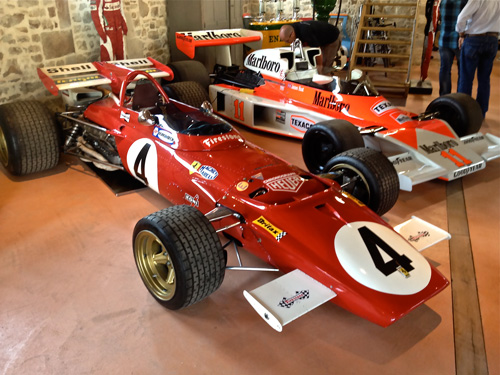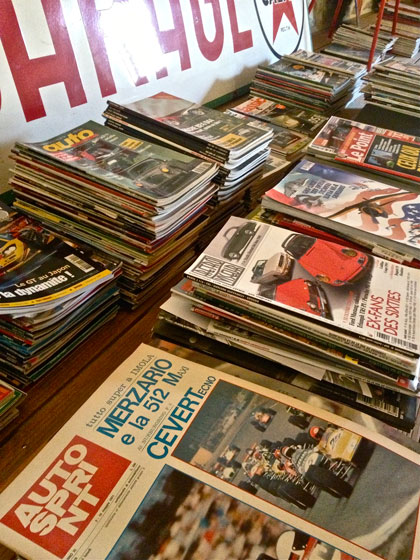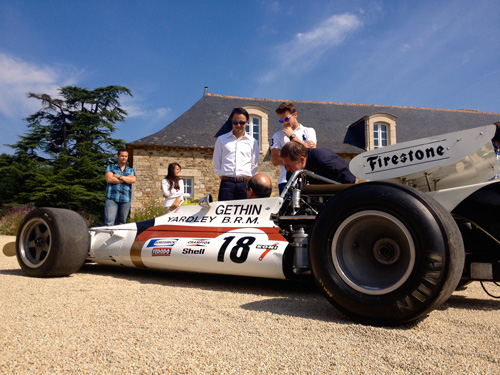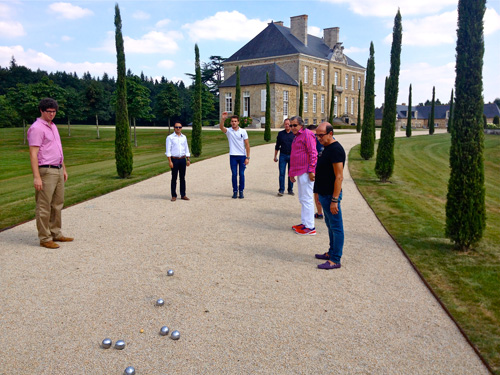It’s only been 12 years. But in that time, Richard Mille has built a brand from scratch that’s now worth a reported SFr400 million. We spent a day with him and asked him, just how did he do it?
Richard Mille starts with a story. ‘I’m banned from driving at the moment,’ he says, squinting from behind small black-rimmed sunglasses as the late summer sun beats down on him. ‘The police caught me doing 151 in a 90 in my GT40 and they banned me for six months. I said to them, “I don’t have a speedometer,” and they were nice to me. Normally, if you are going this fast, they take your car away.’
Mille is clearly amused by all this, and he chuckles as he recalls his brush with the gendarmes. He’s not done. Not only was he speeding, he continues, he was also on slicks clearly marked as not for road use, a crime that on another day might have seen him and his car dealt with rather more forcibly. A friend of his ‘who knows how to write a good letter’, he goes on, managed to get his ban halved. You get the impression the telling of the tale will long outlive Mille’s driving hiatus.
His audience for this particular recital here at Mille’s home in the Brittany countryside includes more than one current Formula 1 driver and has been brought together by Martin Brundle, once an F1 driver himself, who now works as a presenter for Sky TV’s F1 channel. Brundle and his crew are here to film some segments for his show, and he’s invited a few hangers-on along for the ride (me).
Handshakes on arrival – only a moment before the driving ban story – come from Mille, Brazilian Ferrari F1 driver Felipe Massa and the young French Marussia F1 driver Jules Bianchi, both of whom Mille has taken under his wing and whose arms brandish his timepieces. Later, for reasons that are never quite clear, Ilie Nastase will join us for lunch and dinner (yes, the former world number 1 Romanian tennis player – and Hublot ambassador).
 Mille is keen to show us his cars. In the grounds of his magnificent and impressively extravagant 18th Century chateau (he and his wife have restored it over a 12-year-period and transformed it into the kind of plush taxidermist utopia you only ever see on the pages of highfalutin interior design magazines), is Mille’s ‘office’. He takes a certain delight in calling it that – while the immaculately converted barn is indeed home to a computer and a desk chair, it’s also where he keeps some of his collection of one-off historical racecars.
Mille is keen to show us his cars. In the grounds of his magnificent and impressively extravagant 18th Century chateau (he and his wife have restored it over a 12-year-period and transformed it into the kind of plush taxidermist utopia you only ever see on the pages of highfalutin interior design magazines), is Mille’s ‘office’. He takes a certain delight in calling it that – while the immaculately converted barn is indeed home to a computer and a desk chair, it’s also where he keeps some of his collection of one-off historical racecars.
 Mille is keen to show us his cars. In the grounds of his magnificent and impressively extravagant 18th Century chateau (he and his wife have restored it over a 12-year-period and transformed it into the kind of plush taxidermist utopia you only ever see on the pages of highfalutin interior design magazines), is Mille’s ‘office’. He takes a certain delight in calling it that – while the immaculately converted barn is indeed home to a computer and a desk chair, it’s also where he keeps some of his collection of one-off historical racecars.
Mille is keen to show us his cars. In the grounds of his magnificent and impressively extravagant 18th Century chateau (he and his wife have restored it over a 12-year-period and transformed it into the kind of plush taxidermist utopia you only ever see on the pages of highfalutin interior design magazines), is Mille’s ‘office’. He takes a certain delight in calling it that – while the immaculately converted barn is indeed home to a computer and a desk chair, it’s also where he keeps some of his collection of one-off historical racecars.Alongside his 1965 GT40 are Jim Clark’s 1965 South African Grand Prix-winning Lotus, James Hunt’s 1976 McLaren M23, the BRM that won the ‘fastest grand prix in history’ at Monza in 1971, and a 1970 Ferrari 312B, which, as watch types tend to know, became the first F1 car to carry a watch brand logo when Jack Heuer gave the team his backing. The Ferrari, says Mille, is still ‘in its juice’, unrefurbished and exactly as it was 40 years ago. It is a thing of mesmerizing and intimidating beauty.
Mille, it turns out, is an avid collector of many things. He has an estimated 3,000 car magazines and owns the only complete Concorde manual. In his office there’s a Martin-Baker ejector seat and a mirror with a surround made from the air intake of a Boeing 737. He even has one of Yohan Blake’s running shoes, although that’s not surprising given the Jamaican sprinter is one of Mille’s high-profile sports ambassadors.
For some reason, though, he doesn’t consider himself a collector. ‘No, I’m not a collector,’ he says when asked by Brundle if he sees his cars as investments. ‘I am not impulsive. I buy what I love.’ Whether this argument stacks up or not seems irrelevant. His collection of cars and automobile ephemera is awesome – and rising in value. Vintage cars with historic links have made their owners vast returns in the last few years. Mille struggles to place a value on his.
 His collection – make no mistake, that’s what it is – obviously inspires him. His watches were first described as racing machines for the wrist years ago, and the synergies between his two passions are palpable, not to mention well documented.
His collection – make no mistake, that’s what it is – obviously inspires him. His watches were first described as racing machines for the wrist years ago, and the synergies between his two passions are palpable, not to mention well documented.
 His collection – make no mistake, that’s what it is – obviously inspires him. His watches were first described as racing machines for the wrist years ago, and the synergies between his two passions are palpable, not to mention well documented.
His collection – make no mistake, that’s what it is – obviously inspires him. His watches were first described as racing machines for the wrist years ago, and the synergies between his two passions are palpable, not to mention well documented.But what’s unexpected is that all his cars are so old. Instead of a Bugatti Veyron or a Pagani Huayra parked on his drive, brimming with space-tech, he has a 1975 World Rally Championship-winning Lancia Stratos, complete with panels attached by old-school clips.
That doesn’t mean there’s no connection between the two. In their own way, each of his cars pushed boundaries and achieved the exceptional. With my amateur shrink hat on, I find myself wondering if his watches, for all their hyper-modernity, are designed to capture the same sense of wonder he must have felt in his youth when he saw these cars for the first time. If invoking wonder was part of his original mission, he’s succeeded.
Having done the tour, it comes to that time to sit down for a chat. Richard Mille the brand was launched when Richard Mille the man was 50. Now 62, he owns a company worth an estimated SFr 400 million. Talks of Kering, formerly PPR, taking a controlling stake may have gone quiet for now, but a big-money takeover may not be far away. Knowing all this and having seen the fruits of his labours at first hand, the first thing I can find to ask him is simply, how in the world did he make it all happen?
Annoyingly, for those of us looking for a tidy soundbite, he’s not really sure. He talks about his passion and having a dream, as well as adhering to the three pillars of his concept (roughly, innovation, ergonomics and no expense spared). He also says he was just sure that he would find clients who would buy his astronomically expensive watches. How was he sure? ‘I refused to do any market research,’ he says. ‘And I didn’t study the competition.’
 All he knew, he says, was that high-end watch brands at the time were manufacturing 19th century mechanical watches using modern tools and techniques. He wanted to develop 21st century mechanical watches, and believed there would be a market for them. And, as we now know, there was.
All he knew, he says, was that high-end watch brands at the time were manufacturing 19th century mechanical watches using modern tools and techniques. He wanted to develop 21st century mechanical watches, and believed there would be a market for them. And, as we now know, there was.
 All he knew, he says, was that high-end watch brands at the time were manufacturing 19th century mechanical watches using modern tools and techniques. He wanted to develop 21st century mechanical watches, and believed there would be a market for them. And, as we now know, there was.
All he knew, he says, was that high-end watch brands at the time were manufacturing 19th century mechanical watches using modern tools and techniques. He wanted to develop 21st century mechanical watches, and believed there would be a market for them. And, as we now know, there was.Maybe it was genius. Maybe it was savvy. Or just luck. I can’t say. Whatever the reason, the resulting Richard Mille empire is impressive. At the moment, retail prices for his men’s collection start at €65,000, with an average price of €135,000. He’s already selling 2,500 pieces a year and reckons he can double that with the brand’s new facility in Les Breuleux now up and running. That could easily mean annual sales in excess of half a billion euros. Not bad for a project he began because he wanted to make ‘a product that has the symbol of my passion’.
Perhaps not surprisingly, he’s comfortable in his success. ‘I haven’t been stressed in 10 years,’ he says on more than one occasion. That can’t possibly be true, you think, but then when you see him lunching peacefully under the branches of the apple trees in his orchard, surrounded by his beautiful wife, their children and a disparate group of people he persistently refers to as ‘friends’, perhaps it could.
As the time comes for me to leave his rural idyll, he extends his arms and gives me a warm embrace. Mille is good at hugs and high-fives – throughout the day Massa and he have hugged and fist-bumped like a father and his favourite son after a particularly good day on the golf course.
It’s been a privilege, I say to him, and he looks almost bashful, pleased to have entertained and enthralled. I’ve been agog casting an envious eye over all his cars, so much so that I’ve almost overlooked the watch on his wrist – an RM-011 Felipe Massa prototype that’ll be launched at SIHH next year.
Too much to look at. Too much to talk about. Too much to take in in one day. ‘Come again,’ he says. I just might take him up on that. I really might.

Too much to look at. Too much to talk about. Too much to take in in one day. ‘Come again,’ he says. I just might take him up on that. I really might.

Featured brand





